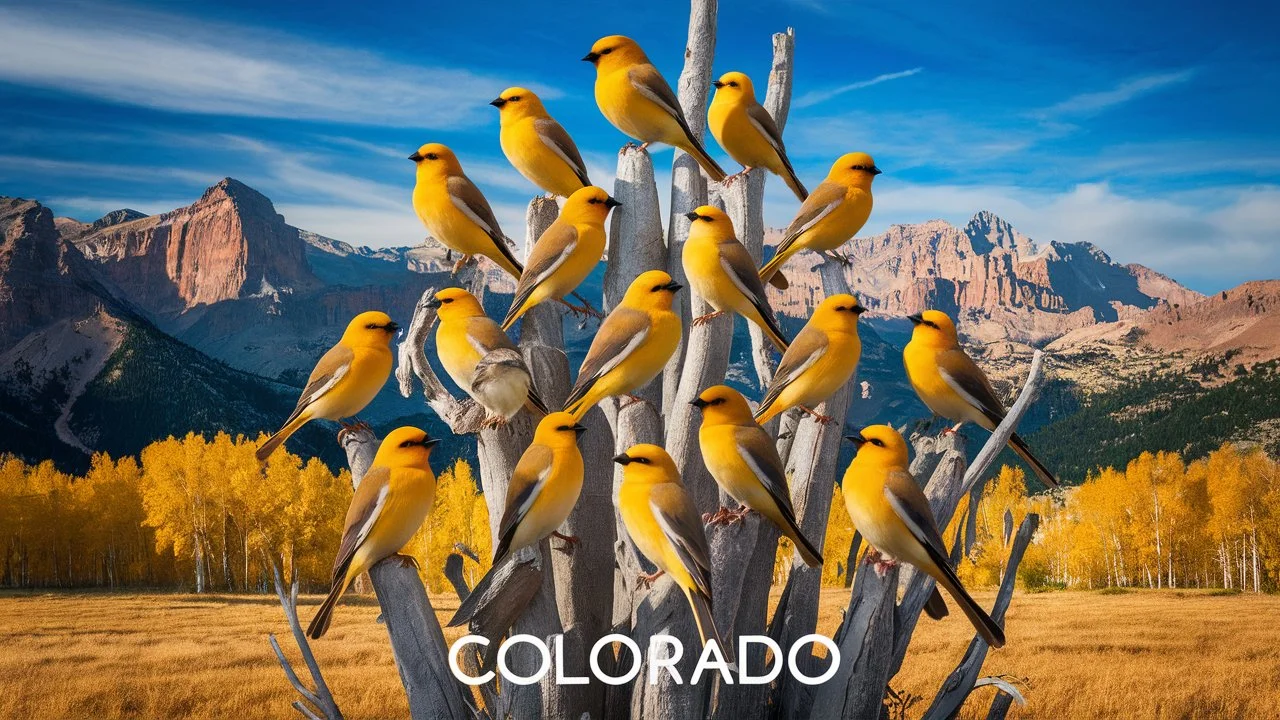Colorado is home to many beautiful birds, including several species with vibrant yellow feathers. These yellow birds add a splash of color to the state’s diverse landscapes. Whether you are a bird watcher or just enjoy nature, spotting these yellow birds can be a delightful experience.
This guide will introduce you to 15 yellow birds you can find in Colorado, helping you identify them and learn about their habits and habitats. Let’s explore these charming creatures and discover what makes each one unique.
Yellow Birds in Colorado: Song and ID Guide
Colorado is home to a variety of yellow birds that add a splash of color and joy to its diverse landscapes. This guide introduces you to 15 yellow birds commonly found in the state, highlighting their unique songs and identification features. Whether you’re an avid bird watcher or a nature enthusiast, this guide will help you recognize and appreciate these beautiful creatures as they sing and flutter through Colorado’s meadows, forests, and wetlands. Let’s explore the vibrant world of Colorado’s yellow birds and learn how to identify them by their distinctive songs and appearances.
Related reading: Do Cardinals Mate for Life?
1. American Goldfinch (Spinus tristis)
The American Goldfinch is a delightful yellow bird with bright yellow plumage, making it a vibrant sight to behold. This small songbird, known for its cheerful appearance, is often referred to as the “wild canary” due to its striking yellow coloration.

Distinct Features:
- Bright yellow plumage (male)
- Black cap and wings (male)
- Muted olive-yellow coloration (female)
Habitat:
- Open fields
- Meadows
- Gardens
Behavior:
- Melodious songs: Known for their lively and melodious songs, which often include a mix of warbling and twitters.
- Acrobatic flight patterns: Gracefully move from tree to tree.
- Specialized diet of seeds: Particularly fond of sunflower seeds, thistle seeds, and various other plant species found in their habitat.
The American Goldfinch can be found in various habitats across the United States, including Colorado. Its preferred habitats include open fields, meadows, and gardens, where it can be seen perched on tree branches or soaring through the air.
One of the distinct features of the American Goldfinch is its ability to change its plumage throughout the year. During the breeding season, the male flaunts a bright yellow plumage with a black cap and wings, while the female showcases a more muted olive-yellow coloration. However, during the winter months, both male and female American Goldfinches adopt a more subdued plumage, blending in with the surrounding vegetation.
Despite their small size, American Goldfinches are known for their lively and melodious songs, which often include a mix of warbling and twitters. If you’re lucky enough to spot an American Goldfinch, you may also notice their acrobatic flight patterns as they gracefully move from tree to tree.
In addition to their bright yellow appearance and beautiful songs, American Goldfinches have a specialized diet that primarily consists of seeds. They are particularly fond of sunflower seeds, thistle seeds, and various other plant species found in their habitat.
The American Goldfinch is a highly adaptable and resilient bird species, capable of thriving in different environments across the country. Its presence adds a touch of color and charm to the Colorado landscape, making it a beloved sight for birdwatchers and nature enthusiasts.
2. Western Tanager (Piranga ludoviciana)
The Western Tanager is another strikingly beautiful bird with bright yellow plumage.
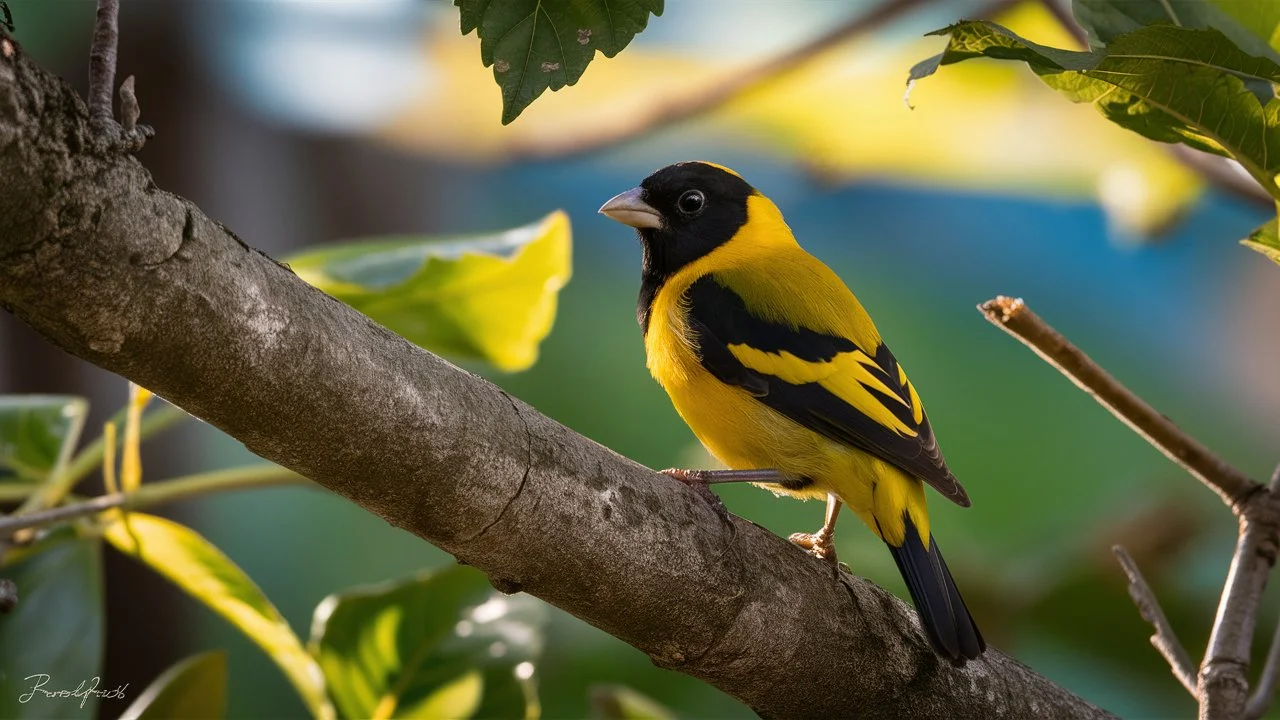
Distinct Features:
- Bright yellow body (male)
- Black wings and back
- Red head (male during breeding season)
Habitat:
- Coniferous and mixed forests
- Open woodlands
- Forest edges during migration
Behavior:
- Insectivorous: Feeds on insects and occasionally fruits.
- Distinctive song: Series of short, sweet notes.
- High foragers: Often seen foraging high in the trees.
Western Tanagers prefer coniferous and mixed forests, often at higher elevations. They can also be found in open woodlands and forest edges during migration. These birds are insectivores, often seen foraging high in the trees. They have a distinctive song, a series of short, sweet notes.
3. Yellow Warbler (Setophaga petechia)
The Yellow Warbler is a small, uniformly yellow bird with a sweet, whistling song.

Distinct Features:
- Bright yellow plumage
- Reddish streaks on breast (male)
Habitat:
- Wetlands
- Willow thickets
- Marshes
- Gardens and parks
Behavior:
- Active foragers: Constantly moving through foliage in search of insects.
- Distinctive song: “Sweet-sweet-sweet, I’m so sweet.”
Yellow Warblers are often found in wet habitats like willow thickets, marshes, and along streams and rivers. They are also common in gardens and parks. These warblers are active foragers, constantly moving through the foliage in search of insects. Their song is a distinctive “sweet-sweet-sweet, I’m so sweet.”
4. Common Yellowthroat (Geothlypis trichas)
The Common Yellowthroat is a small warbler with a distinctive black mask on the face of the males.

Distinct Features:
- Olive back
- Bright yellow throat
- Black mask (male)
Habitat:
- Marshes
- Wetlands
- Areas with dense, low vegetation
Behavior:
- Low foragers: Forages low to the ground, picking insects off leaves and twigs.
- Distinctive song: “Witchety-witchety-witchety.”
These birds are found in marshes, wetlands, and areas with dense, low vegetation. They are often heard before they are seen, as they tend to stay hidden in the underbrush. Common Yellowthroats are known for their “witchety-witchety-witchety” song. They forage low to the ground, picking insects off leaves and twigs.
5.Lesser Goldfinch (Spinus psaltria)
The Lesser Goldfinch is a small finch with yellow underparts and variable back coloration.
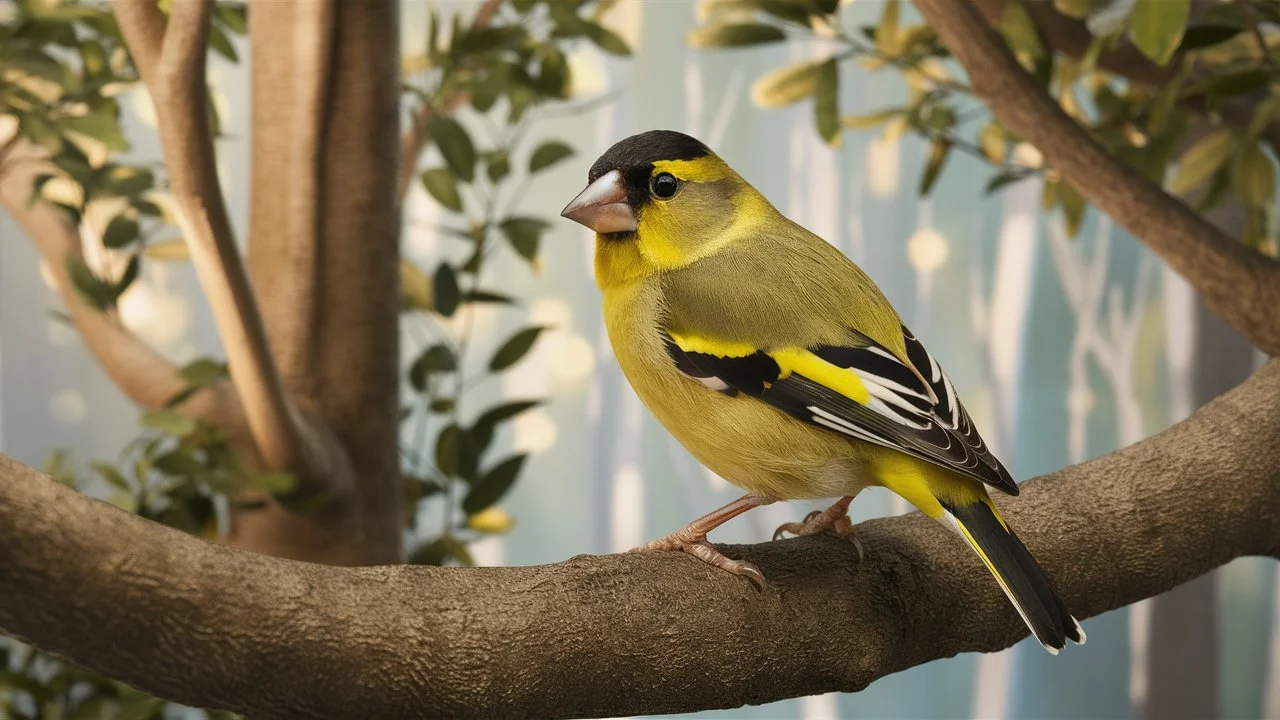
Distinct Features:
- Yellow underparts
- Variable back color (black or greenish-black)
Habitat:
- Scrublands
- Open woodlands
- Gardens
- Feeders
Behavior:
- Social: Often seen in flocks.
- High-pitched song: Rapid series of high notes and trills.
- Undulating flight pattern.
These finches are adaptable and can be found in a variety of habitats, including scrublands, open woodlands, gardens, and feeders. Lesser Goldfinches are social birds, often seen in flocks. They have a high-pitched, twittering song and an undulating flight pattern.
6. Evening Grosbeak (Coccothraustes vespertinus)
The Evening Grosbeak is a large, stocky finch with a massive bill.

Distinct Features:
- Yellow and black plumage (male)
- White wing patches
- Massive bill
Habitat:
- Coniferous forests
- Mixed woodlands
- Feeders (especially in winter)
Behavior:
- Loud, clear calls.
- Seed-cracking bill: Powerful bill for cracking seeds.
These birds are typically found in coniferous forests and mixed woodlands. They may also visit feeders, especially in winter. Evening Grosbeaks are known for their powerful, seed-cracking bills. They have a loud, clear call that can be heard from a distance.
7. Yellow-headed Blackbird (Xanthocephalus xanthocephalus)
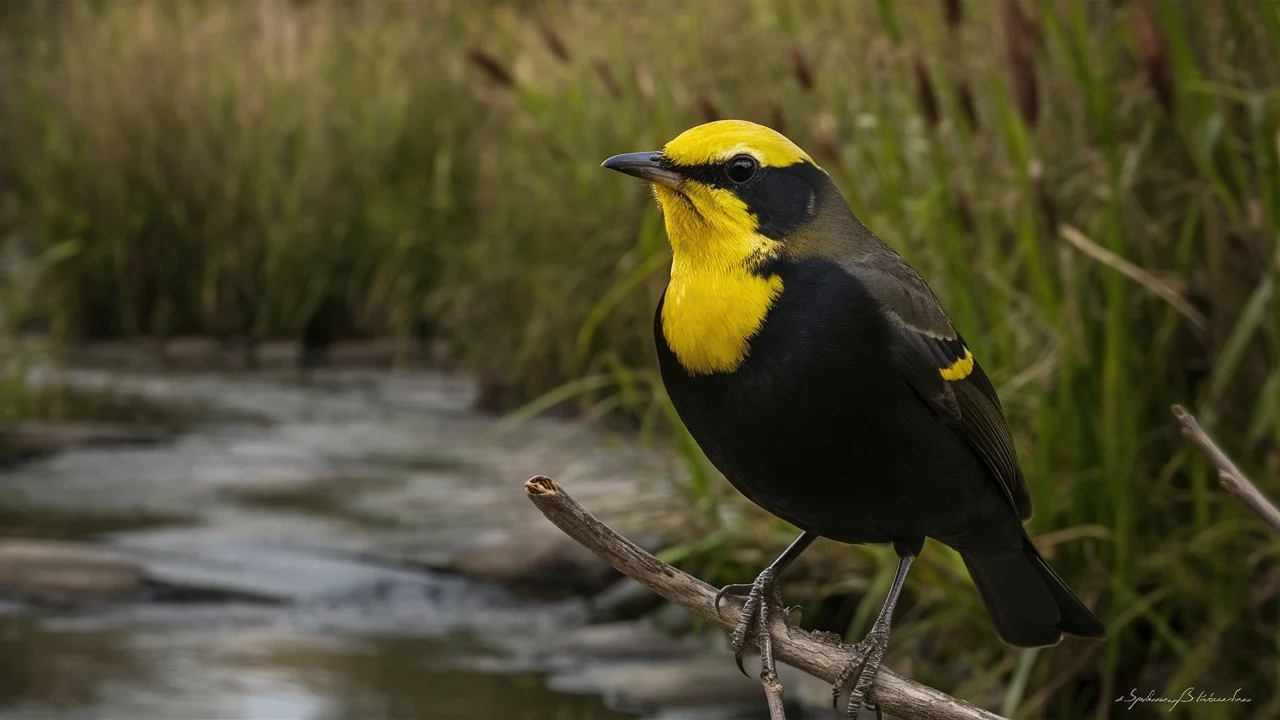
The Yellow-headed Blackbird is known for its bright yellow head and chest with a black body.
Distinct Features:
- Bright yellow head and chest
- Black body
Habitat:
- Marshes
- Wetlands
Behavior:
- Often seen in large flocks.
- Raspy song.
These birds are found in marshes and wetlands. They are often seen in large flocks, with a distinctive raspy song.
8. Prothonotary Warbler (Protonotaria citrea)
The Prothonotary Warbler is known for its bright yellow body with blue-gray wings and tail.
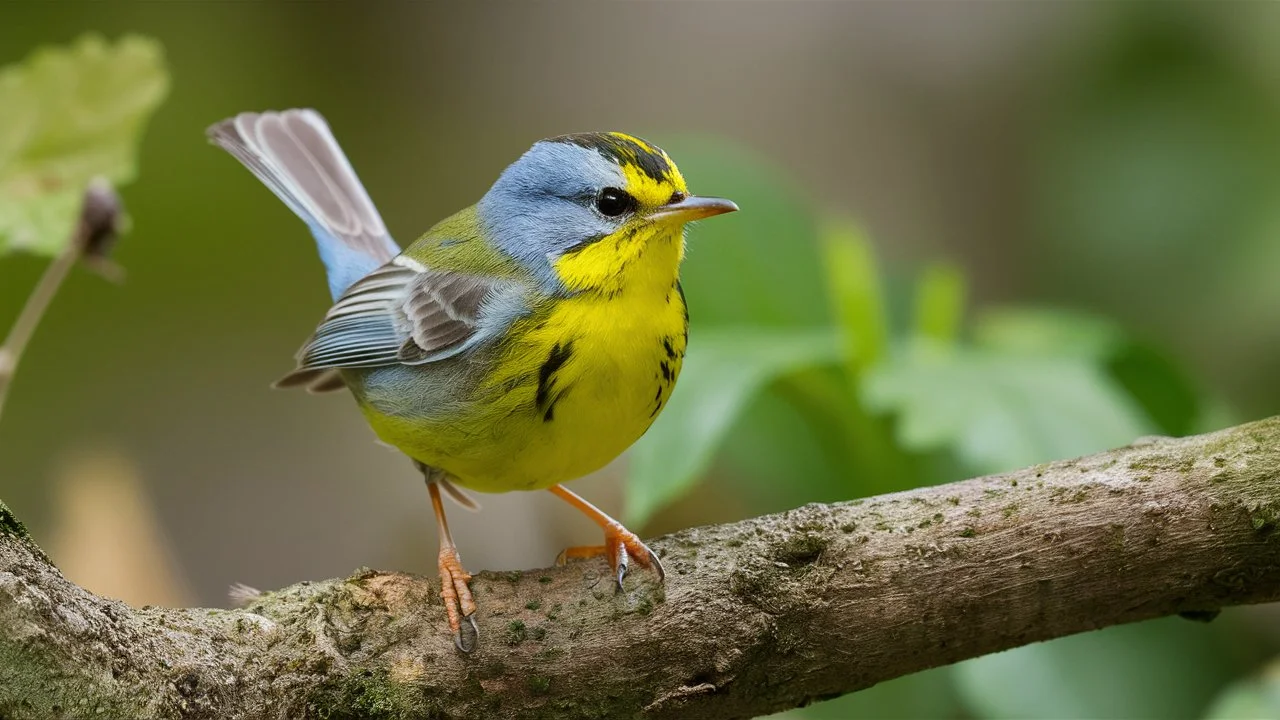
Distinct Features:
- Bright yellow body
- Blue-gray wings and tail
Habitat:
- Swamps
- Bottomland forests
Behavior:
- Forages low in vegetation, often near water.
These warblers prefer swamps and bottomland forests. They forage low in vegetation, often near water.
9. Wilson’s Warbler (Cardellina pusilla)
The Wilson’s Warbler is known for its bright yellow body with a black cap in males.
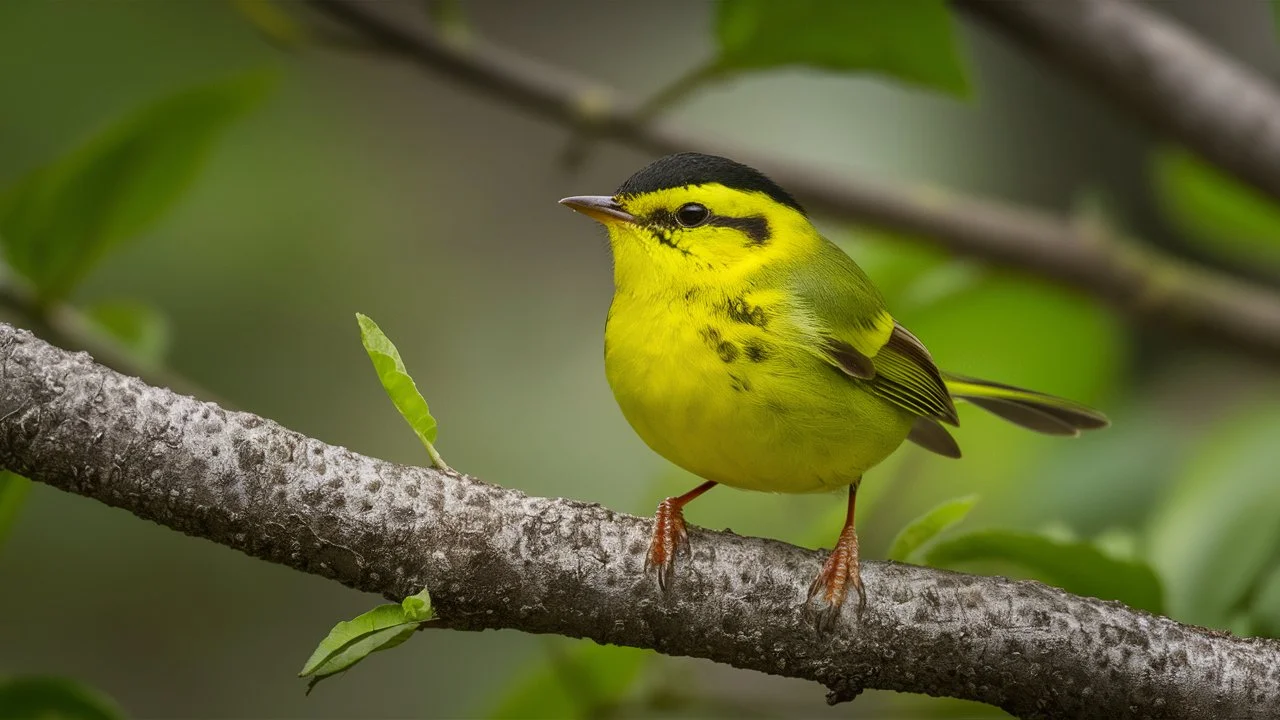
Distinct Features:
- Bright yellow body
- Black cap (male)
Habitat:
- Wetlands
- Riparian areas
- Shrubby fields
Behavior:
- Active foragers, flitting through foliage.
These warblers are found in wetlands, riparian areas, and shrubby fields. They are active foragers, flitting through foliage.
10. Yellow-rumped Warbler (Setophaga coronata)
The Yellow-rumped Warbler is known for its yellow patch on the rump, along with yellow sides and crown.
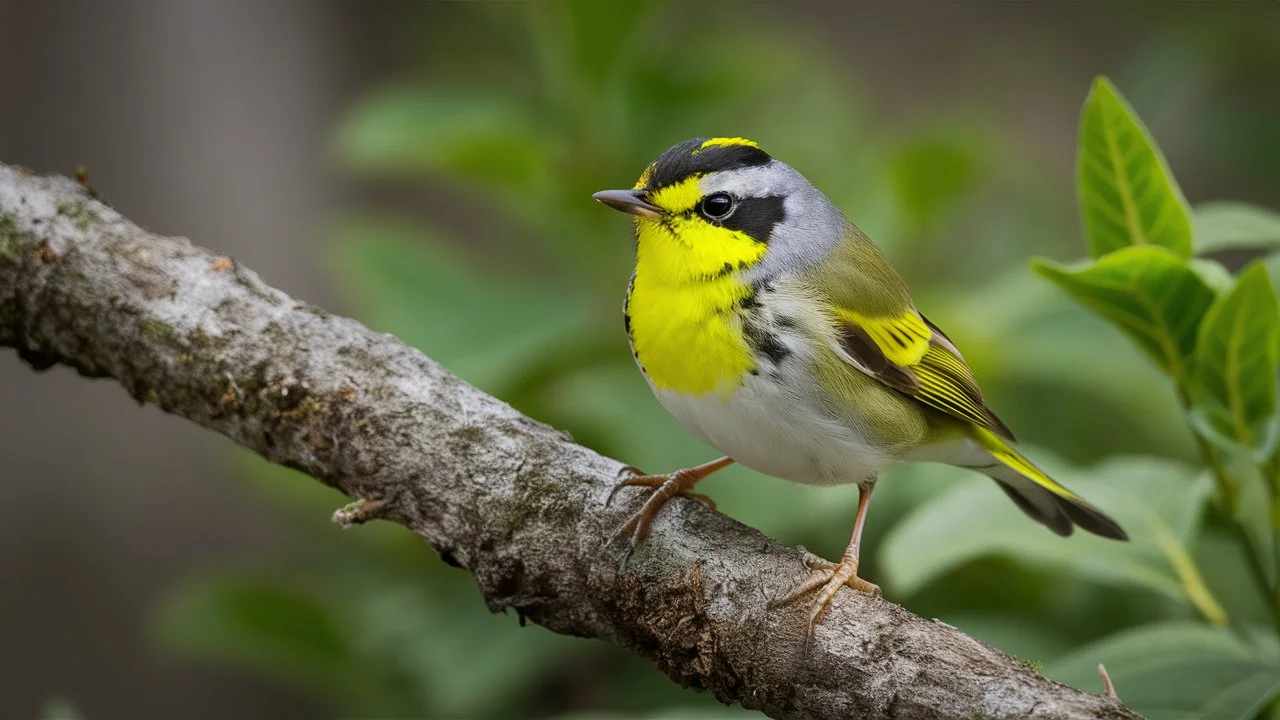
Distinct Features:
- Yellow patch on the rump
- Yellow sides and crown
Habitat:
- Coniferous and mixed forests
Behavior:
- Forages for insects and berries, often in flocks during migration.
These warblers are found in coniferous and mixed forests. They forage for insects and berries, often in flocks during migration.
11. Magnolia Warbler (Setophaga magnolia)
The Magnolia Warbler is known for its yellow underparts with black streaks and a distinctive black mask.
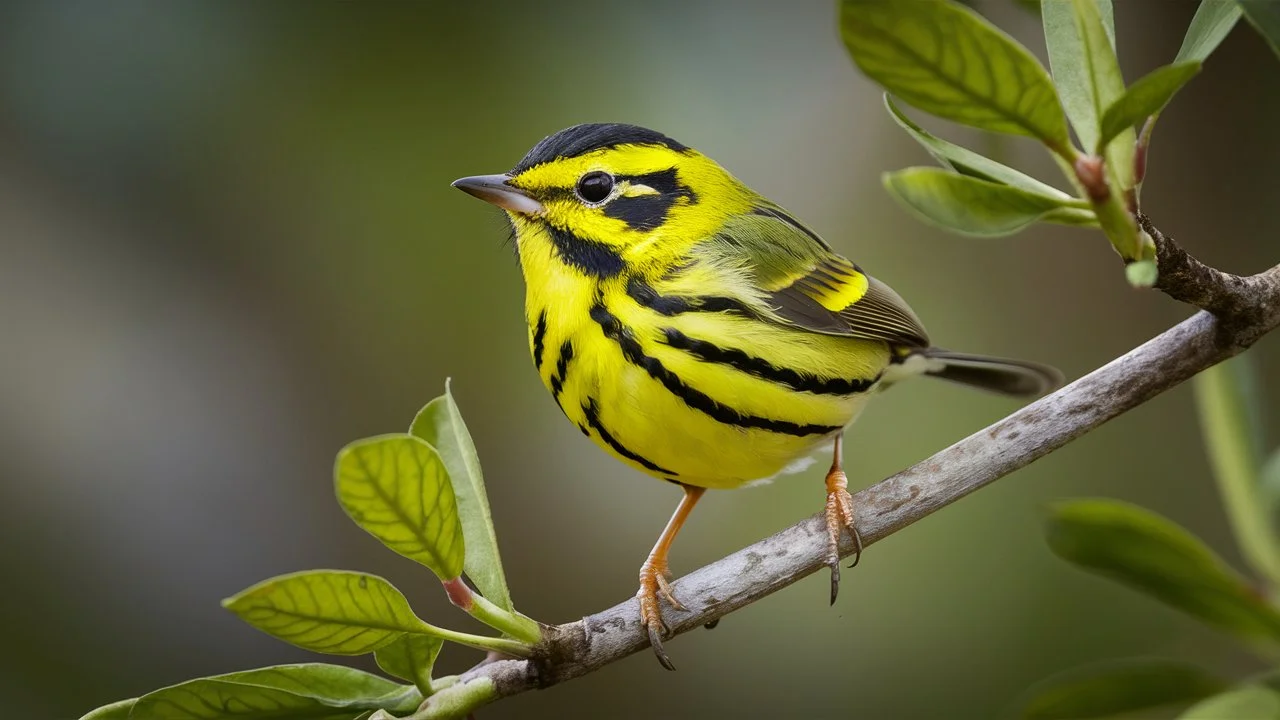
Distinct Features:
- Yellow underparts with black streaks
- Black mask
Habitat:
- Coniferous forests, especially during migration.
Behavior:
- Active and acrobatic foragers, often seen in the lower canopy.
These warblers are found in coniferous forests, especially during migration. They are active and acrobatic foragers, often seen in the lower canopy.
12. Pine Warbler (Setophaga pinus)
The Pine Warbler is known for its olive-yellow body with white wing bars.
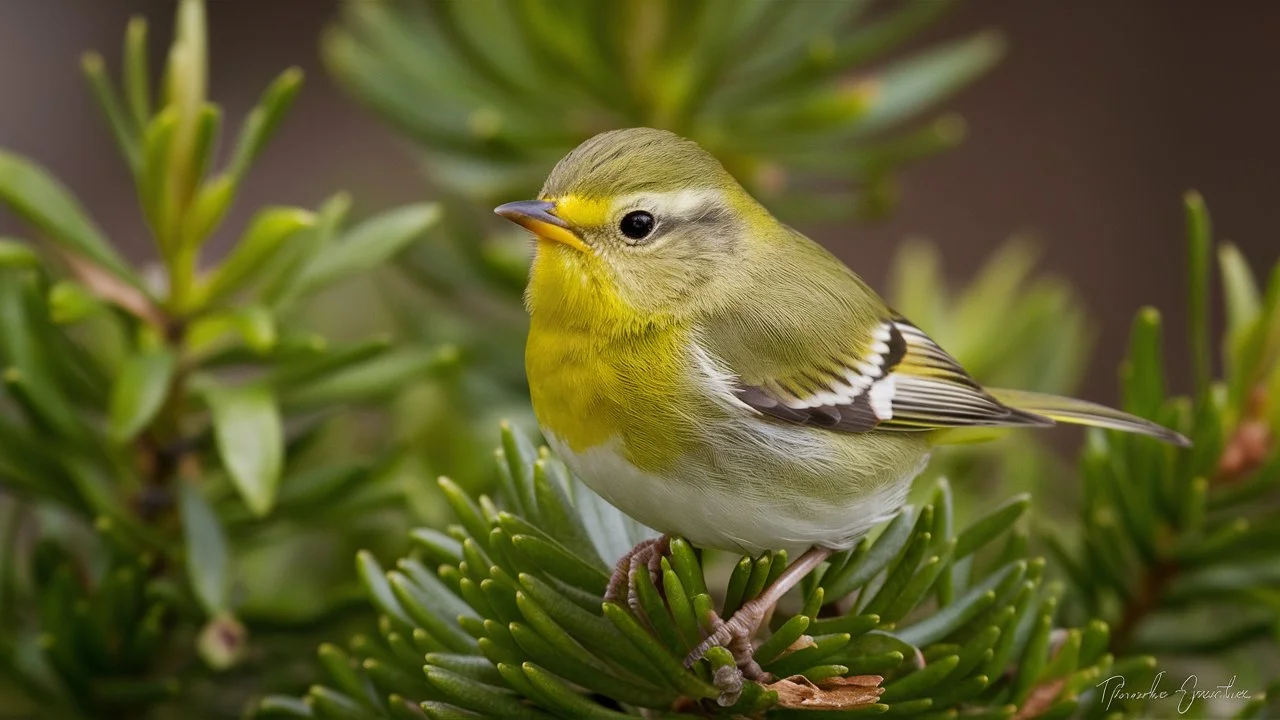
Distinct Features:
- Olive-yellow body
- White wing bars
Habitat:
- Pine forests
Behavior:
- Forages in pine trees, often in mixed-species flocks
These warblers are typically found in pine forests. They forage in pine trees and are often seen in mixed-species flocks.
13. Canada Warbler (Cardellina canadensis)
The Canada Warbler is known for its bright yellow underparts with a distinctive black “necklace.”

Distinct Features:
- Bright yellow underparts
- Black “necklace”
Habitat:
- Dense, moist forests and thickets
Behavior:
- Forages low to mid-level in dense vegetation
These warblers are typically found in dense, moist forests and thickets. They forage low to mid-level in dense vegetation.
14. Western Kingbird (Tyrannus verticalis)
The Western Kingbird is known for its pale yellow belly with gray upperparts and a black tail with white edges.
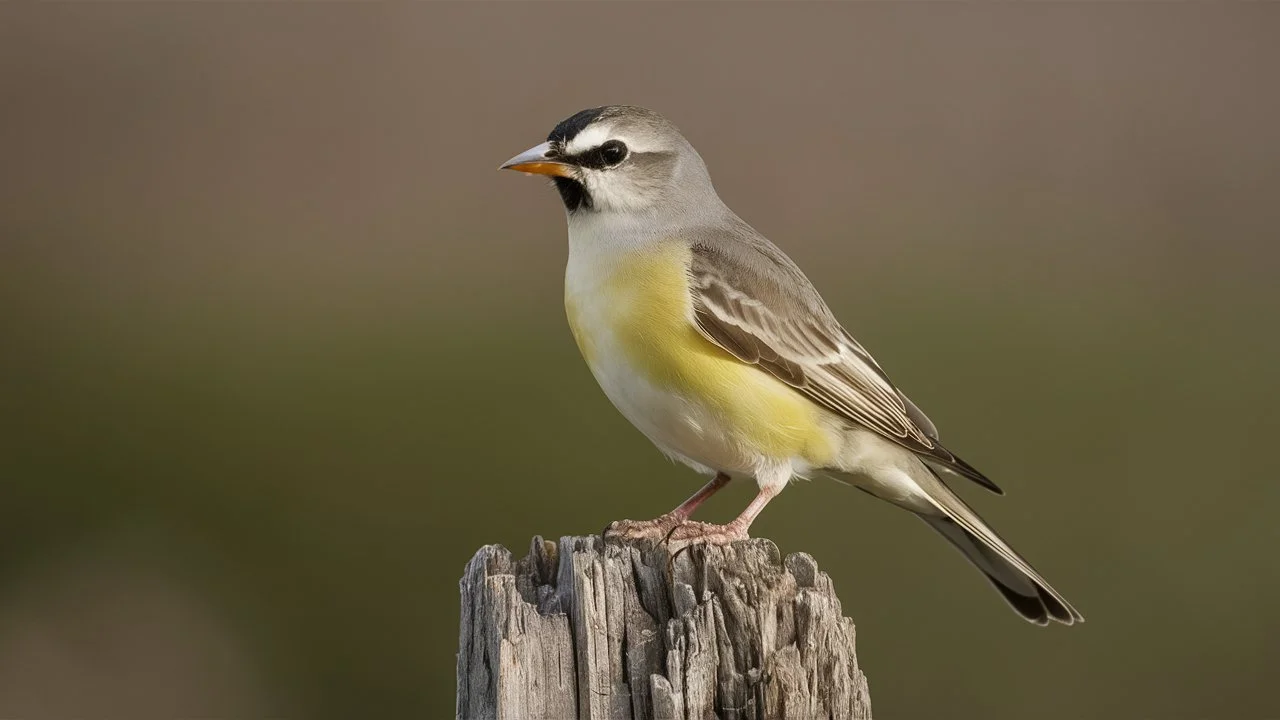
Distinct Features:
- Pale yellow belly
- Gray upperparts
- Black tail with white edges
Habitat:
- Open areas, including grasslands and farmlands
Behavior:
- Sits on exposed perches, catching insects in flight
These kingbirds are typically found in open areas, including grasslands and farmlands. They are often seen sitting on exposed perches, catching insects in flight.
15. Yellow-breasted Chat (Icteria virens)
The Yellow-breasted Chat is known for its large size, bright yellow breast, and white spectacles.
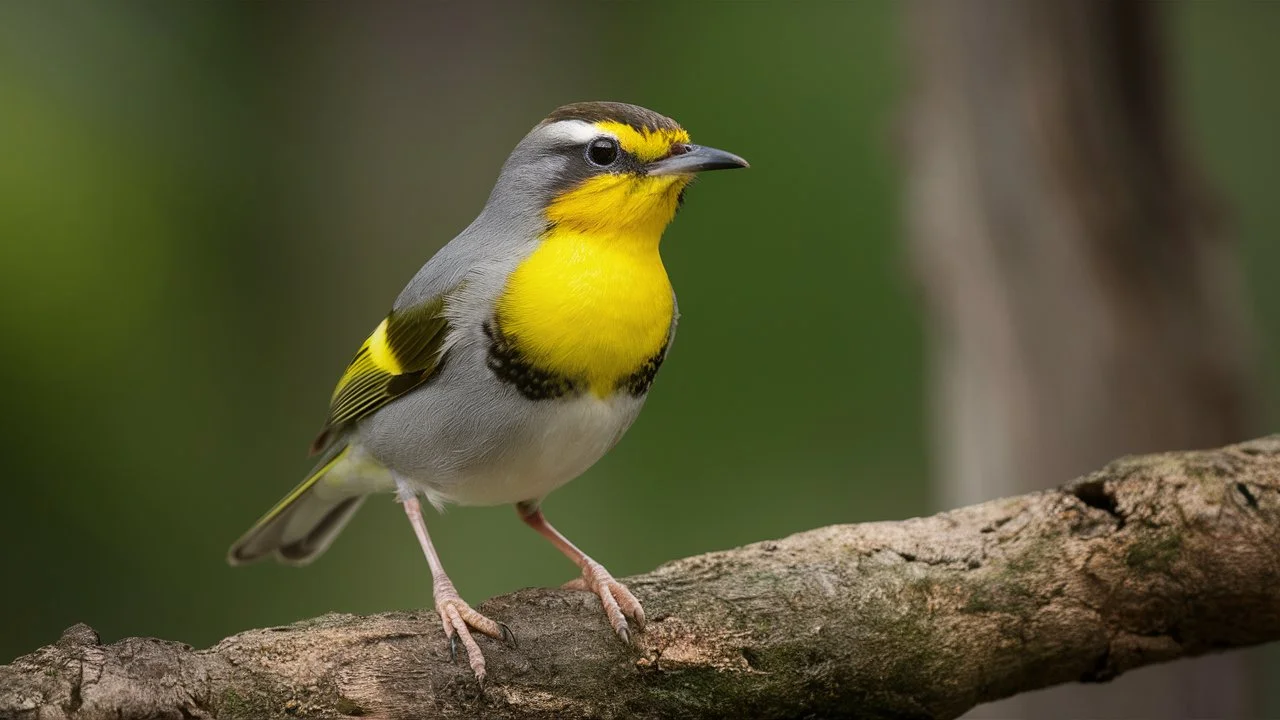
Distinct Features:
- Large size
- Bright yellow breast
- White spectacles
Habitat:
- Dense shrubs and thickets
Behavior:
- Secretive and skulking, often heard rather than seen, with a varied song
These chats are typically found in dense shrubs and thickets. They are secretive and skulking, often heard rather than seen, with a varied song.
Observing Yellow Birds in Colorado
Best Times for Bird Watching
- Spring and Summer: Breeding season, when birds are most colorful and active.
- Early Morning: Birds are more active and vocal.
Recommended Bird Watching Locations
- Rocky Mountain National Park: A premier destination for bird watchers, offering diverse habitats and a wide variety of bird species, including many yellow birds.
- Barr Lake State Park: Known for its rich bird life, this park provides excellent opportunities to see a variety of yellow birds, especially during migration periods.
- Chatfield State Park: With its mix of wetlands, forests, and open water, Chatfield State Park is another great spot for bird watching.
Bird Watching Gear
- Binoculars: Essential for spotting and identifying birds from a distance.
- Field Guide: Helps with identifying different species and learning about their behaviors.
- Notebook: Useful for recording observations and noting locations.
Conservation Efforts
Many yellow bird species are protected under the Migratory Bird Treaty Act. Conservation efforts focus on preserving habitats, especially wetlands and forests, which are crucial for the survival of these birds. Supporting local conservation organizations and participating in bird counts can help protect these vibrant species.
Summary of Key Features, Habitats, and Behaviors
| Bird | Distinct Features | Habitat | Behavior |
|---|---|---|---|
| American Goldfinch | Bright yellow plumage, black cap (male), olive-yellow (female) | Open fields, meadows, gardens | Melodious songs, acrobatic flight, seed diet |
| Western Tanager | Yellow body, black wings, red head (male) | Coniferous, mixed forests | Insectivorous, sweet song, high foragers |
| Yellow Warbler | Bright yellow, reddish streaks (male) | Wetlands, willow thickets | Active foragers, sweet song |
| Common Yellowthroat | Olive back, yellow throat, black mask (male) | Marshes, wetlands | Low foragers, “witchety-witchety” song |
| Lesser Goldfinch | Yellow underparts, variable back color | Scrublands, woodlands, gardens | Social, high-pitched song |
| Evening Grosbeak | Yellow and black (male), white wing patches | Coniferous forests, feeders | Loud calls, seed-cracking bill |
| Yellow-headed Blackbird | Yellow head and chest, black body | Marshes, wetlands | Large flocks, raspy song |
| Prothonotary Warbler | Yellow body, blue-gray wings | Swamps, bottomland forests | Low foragers, near water |
| Wilson’s Warbler | Yellow body, black cap (male) | Wetlands, riparian areas | Active foragers |
| Yellow-rumped Warbler | Yellow rump, sides, crown | Coniferous, mixed forests | Forages for insects, berries |
| Magnolia Warbler | Yellow underparts, black streaks, mask | Coniferous forests | Active foragers |
| Pine Warbler | Olive-yellow, white wing bars | Pine forests | Forages in pines |
| Canada Warbler | Yellow underparts, black “necklace” | Moist forests | Low to mid-level foragers |
| Western Kingbird | Pale yellow belly, gray upperparts | Open areas | Catches insects in flight |
| Yellow-breasted Chat | Large, yellow breast, white spectacles | Dense shrubs | Secretive, varied song |
Enjoy the vibrant and varied bird life in Colorado, and happy bird watching
Conclusion
Colorado’s yellow birds add a splash of color to the state’s diverse landscapes. From the bright American Goldfinch to the elusive Yellow-breasted Chat, these birds offer endless opportunities for bird watchers and nature lovers. By understanding their habitats and behaviors, you can enjoy and contribute to the conservation of these beautiful avian species
